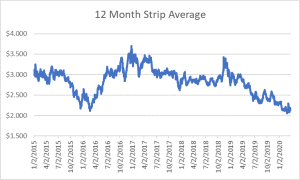Natural Gas Storage Summary
For natural gas report week, March 26, 2020, the EIA reported a net decrease in storage of 29 Bcf, in line with projections ranging from a withdrawal of 14 Bcf to a draw of 36 Bcf. Last year for the same week there was a withdrawal of 39 Bcf and the five-year average is a withdrawal of 40 Bcf.
Working gas in storage was 2,005 Bcf as of Friday, March 20th, 2020 per EIA estimates. Inventory was reported at 888 Bcf (79.5%) higher than last year for the same week and 292 Bcf (17.0%) more than the five-year average of 1,713 Bcf.
Natural Gas Market Recap
April NYMEX

Settled Thursday at $1.637/Dth, down 2.2 cents from Wednesday’s close at $1.659/Dth.
12 Month Strip

Settled Thursday at $2.161/Dth, up 1.2 cents from last Thursday.
Seasonal Strips
The summer diminishing strip (APR20-OCT20) settled Thursday at $1.877/Dth, down 1.3 cents from the prior week. The winter forward strip (NOV20-MAR21) settled Thursday at $2.558/Dth, up 4.7 cents from last Thursday.
Natural Gas Weekly
Natural Gas Report – March 26, 2020
Natural Gas Fundamentals
Overall supply averaged 98.9 Bcf/d last week as production remained unchanged and average net imports from Canada increased by 6%.
Total demand fell by 1% from the prior report week with power-generation and industrial consumption both down by 2%. Residential/commercial consumption remained the same as the prior week while exports to Mexico grew by 1%. LNG exports decreased from last week, down to 15 LNG vessels with a combined carrying capacity of 55 Bcf.
With five days left in withdrawal season, the average rate of withdrawal is 13% less than the five-year average. If the rate of withdrawal from storage matched the five-year average of 1.4 Bcf/d from now until March 31, storage inventory would be 1,989 Bcf which is 292 Bcf higher than the five-year average of 1,697 Bcf.
Natural Gas Prices
With jobless claims in excess of 3.3 million and 160 million people – almost half of the U.S. population – under orders to stay at home, schools have transitioned to online learning and many businesses have temporarily closed. According to Forbes, “Gasoline demand is set to plunge 50%, while jet fuel consumption has all but evaporated, with 87% fewer flyers taking to the air than a year ago.” In addition to billions in capital budget cuts, producers are cutting drilling rigs. That means less associated natural gas.
The changes brought about by COVID-19 also mean industrial and commercial natural gas demand will drop substantially. With short term temperature forecasts predicting mild temperatures, it’s unlikely to be cold enough to spark residential heating demand and not hot enough to prompt growth in power burn consumption. How the exact impact on demand will unfold has yet to be seen. Next week will begin to offer a clearer understanding.
Supply fundamentals aren’t immediately clear either, but last week’s decline in rig counts from 802 to 739 indicates producers aren’t wasting any time in cutting rigs.
So while the market almost seems to be holding it’s breath waiting for clarity, significant cuts in demand will push prices lower short-term, but could mean price inflation as the world attempts to return to normal in the wake of COVID-19.
AES COVID-19 Operational Update
This week Ohio announced implementation of a Stay at Home order which will remain in place through Monday, April 6 or until lifted or otherwise amended. In compliance with this mandate and to continue prioritizing the health of our employees, customers, and communities we have transitioned operations consistent with the contingency plan we informed you about last week. During this time, we will continue to deliver full account support remotely. This change has proceeded with imperceptible impact to our customers and supplier network.
As always, we are here to help. Please call us at (866) 646-7322 with your questions or concerns.

